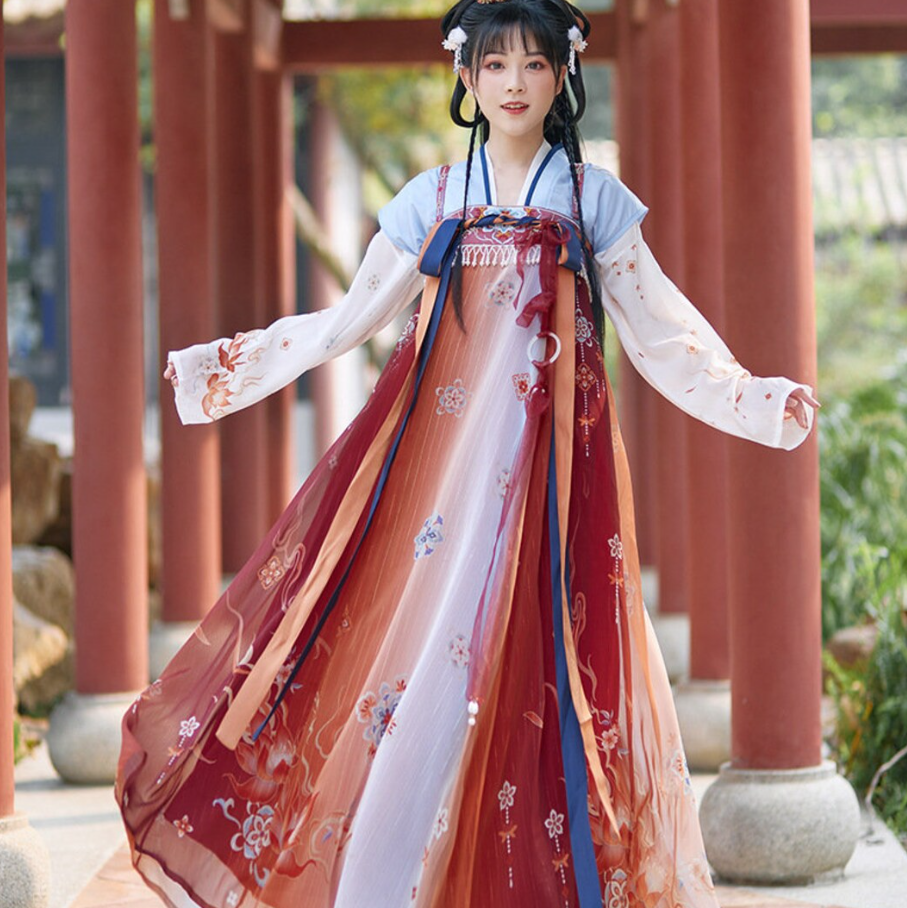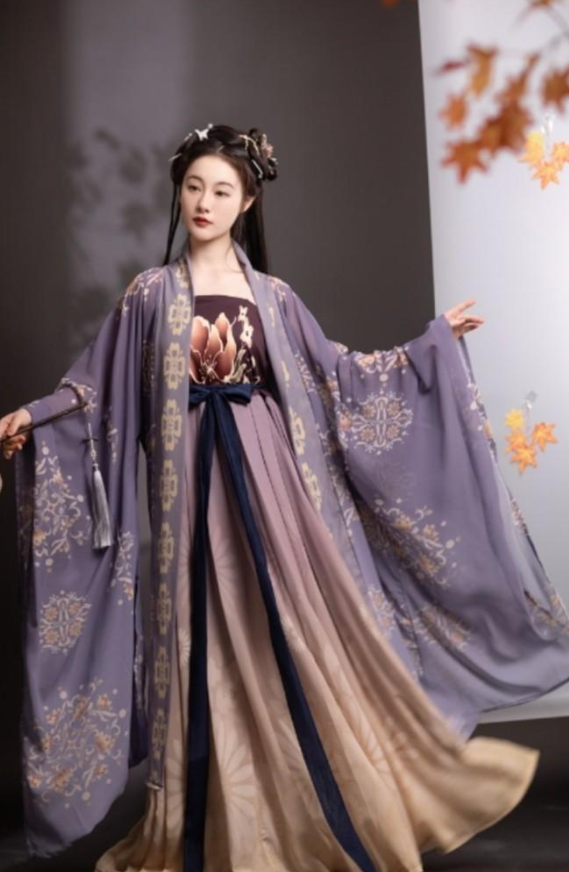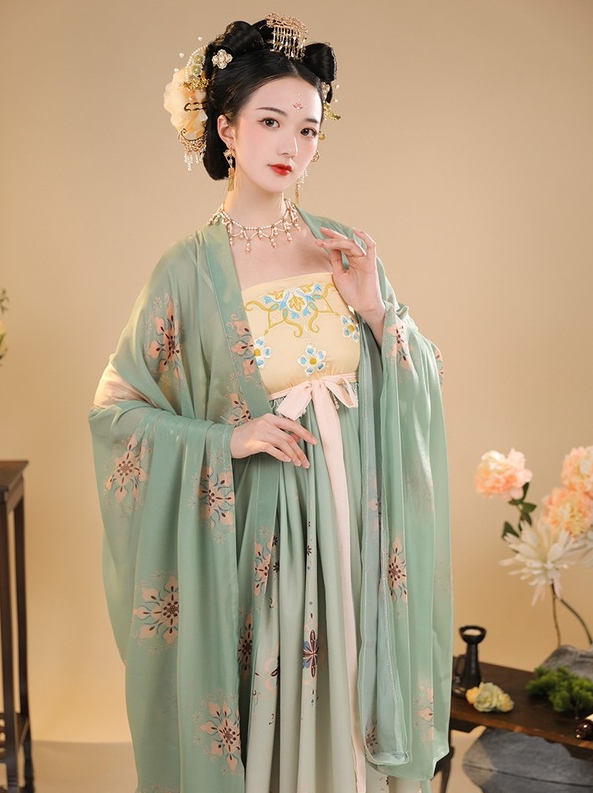To wear Tang Dynasty Hanfu, start with the undergarments, put on the Ruqun, add the Pifeng or Banbi, fasten the waistband, and finalize with appropriate shoes and accessories.
Components of Tang Dynasty Hanfu
Ruqun (襦裙): The blouse and skirt combination
- Materials and Design
- The Ruqun is an iconic Hanfu set from the Tang Dynasty.
- The “Ru” is a blouse with a cross-collar design.
- Traditionally made from silk, with cotton versions also available.
- The “Qun” skirt is tied above the waist with varying lengths.
- Designs can range from simple to intricate patterns and embroideries.
- Wearing Techniques
- Wear the blouse first, ensuring the right side overlaps the left.
- Tie the skirt above the waist.
- Pair with traditional shoes.

Pifeng (披风): The overcoat or cloak
- Materials and Design
- Pifeng is an overcoat or cloak.
- Made from materials like wool or embroidered silk for elites.
- Serves both decorative and functional purposes.
- How to Wear
- Draped over the shoulders.
- Typically sleeveless.
- Some designs have ribbons to tie in front.
- Can be accentuated with a traditional belt.
Shenyi (深衣): A one-piece robe
- Materials and Design
- Shenyi is a one-piece robe.
- Symbolizes unity.
- Typically made from high-quality silk.
- Often showcases intricate patterns, especially on sleeves and hem.
- Wearing Techniques
- Slip it over your head.
- Ensure the collar overlaps correctly: right side over the left.
- Fasten with a sash or belt around the waist.
Banbi (半臂): A half-sleeved short jacket
- Materials and Design
- Banbi is a half-sleeved jacket.
- Made from lightweight materials like silk or fine cotton.
- Designs range from simple to intricate embroideries for nobility.
- How to Wear
- Worn over Ruqun or other inner garments.
- Length typically reaches the waist.
- Fastened at the front.
- Pair with jade pendants or traditional Chinese jewelry.
Steps to Wear Tang Dynasty Hanfu
Preparing the undergarments
Before donning the outer Hanfu, it’s essential to have the right undergarments. Traditionally, Hanfu undergarments are light, breathable, and made of materials like cotton or silk. These undergarments ensure comfort and protect the outer layer from body oils and sweat.
- Underblouse and underpants: Both men and women typically wear a soft, thin underblouse and pants. This provides a layer of protection and ensures that the outer garments drape correctly.
- Underskirt: Women also might wear a simple underskirt, especially when wearing transparent or semi-transparent Ruqun. This helps in adding more volume to the skirt and maintains modesty.
Putting on the Ruqun
The Ruqun, a combination of a blouse and skirt, is fundamental in Hanfu.
- Wearing the blouse: Put on the blouse, ensuring that the right side overlaps the left, adhering to traditional customs. Make sure it’s comfortably fit, not too tight or too loose.
- Securing the skirt: The skirt should be tied just above the waist. Depending on the design, it might have ribbons or ties. It should drape down, ideally reaching the ankles.
Adding the Pifeng or Banbi (if applicable)
Depending on the occasion and weather, you might choose to wear the Pifeng (cloak) or Banbi (short jacket).
- Draping the Pifeng: The Pifeng is an overcoat that drapes over the shoulders. Ensure it hangs evenly on both sides. Some designs have front ties that can be neatly secured.
- Wearing the Banbi: The Banbi is slipped on like a modern jacket. Ensure that it fits comfortably over the Ruqun without bunching up or restricting movement.
Fastening and adjusting the waistband
The waistband or sash is both functional and decorative.
- Choosing the right waistband: Waistbands come in various materials like silk, cotton, or even leather. They can be plain or adorned with embroidery, beads, or even jade pieces. Choose one that complements the overall attire.
- Tying the waistband: Wrap the waistband or sash around the waist over the Ruqun. Depending on its design, it might tie at the front, back, or side. Ensure it’s snug but comfortable, allowing ease of movement.
Wearing the appropriate shoes and accessories
Final touches are crucial. They complete the look and showcase personal style and attention to detail.
- Selecting shoes: Traditional Hanfu shoes are often soft-soled and made of cloth. They can be simple slip-ons or adorned with embroidery. Make sure they’re comfortable, especially if you’ll be standing or walking for extended periods.
- Accessories: Depending on the occasion, you might opt for hairpins, hats, jade pendants, or traditional jewelry. Remember, while accessories can enhance the outfit, they shouldn’t overshadow the beauty of the Hanfu itself.
Hairstyles and Accessories
Traditional Tang Dynasty hairstyles
The Tang Dynasty, one of the most prosperous eras in Chinese history, was also a time of immense creativity in fashion, especially hairstyles. Both men and women had distinct styles that conveyed their social status, age, and occasion.
- Women’s hairstyles: Women in the Tang Dynasty loved intricate hairstyles, often involving multiple buns, braids, and twists.
- High bun with hanging beads: This style was popular among the nobility. Hair was tied into a high bun with ornate hairpins, with strands of beads or pearls cascading down.
- Side buns with braids: Another elegant style was to have braids wrapped around the head with buns on either side. This was a common style for everyday wear among the elite.
- Men’s hairstyles: Men usually wore their hair short or tied in a simple bun.
- Simple topknot: This was the most common style for men, often secured with a hairpin or a simple ribbon.
- Braided topknot: For formal occasions or by scholars, men would braid their hair and then twist it into a topknot, symbolizing knowledge and refinement.
Headpieces and hairpins
Hair accessories were not merely decorative; they also conveyed a person’s social status.
- Hairpins: Made of various materials like silver, gold, wood, or jade, hairpins were essentials for holding hairstyles in place. The more intricate and lavish the design, the higher the status of the wearer. Some hairpins even had dangling components, adding a touch of grace with every movement.
- Headpieces: These were often reserved for special occasions or the elite. Common designs included phoenixes, dragons, and flowers, symbolizing good fortune, power, and beauty, respectively. They could be adorned with pearls, gemstones, or delicate silks.

Jewelry and other adornments
The Tang Dynasty was a period of opulence, and this was reflected in the jewelry and adornments people wore.
- Earrings: Large, droplet-shaped earrings made of gold or silver, often embedded with pearls or semi-precious stones, were popular among women of the upper class.
- Necklaces and Pendants: Multi-layered necklaces with jade or gold pendants were common. Jade, in particular, was highly valued, believed to bring protection and good luck to the wearer.
- Bangles and bracelets: Made from jade, gold, or silver, these were worn by both men and women. For men, simple jade bangles were a symbol of status, while women often wore more intricate designs.
Care and Maintenance of Hanfu
Cleaning recommendations
Hanfu, often made from delicate materials like silk, requires careful cleaning to maintain its quality and appearance.
- Hand washing: It’s best to hand wash Hanfu using cold water to prevent color fading and fabric shrinkage. Use a gentle detergent, and avoid wringing the fabric. Instead, press out excess water gently between towels.
- Avoiding harsh chemicals: Bleaches or strong detergents can damage the fabric and fade the colors. Stick to mild soaps or detergents specifically designed for delicate materials.
- Dry cleaning: For more intricate or heavily embroidered Hanfu, consider professional dry cleaning. This ensures the fabric and embroidery are not damaged during the cleaning process.
Storing the Hanfu properly
Proper storage ensures the longevity and beauty of your Hanfu garments.
- Hanging: Use padded hangers to hang Hanfu to maintain its shape. This is especially important for heavier or embroidered garments to prevent stretching.
- Avoid direct sunlight: Store Hanfu in a cool, dark place. Direct sunlight can fade the colors over time.
- Moth prevention: Use natural moth repellents like cedarwood or lavender sachets when storing your Hanfu. This keeps the garment safe from moth damage without introducing harmful chemicals.
- Breathable storage bags: If using storage bags, opt for breathable fabric bags instead of plastic. This allows the Hanfu to breathe, preventing mold and mildew.
Repairing and preserving the fabric
Despite best care efforts, Hanfu may need repairs over time. Knowing how to maintain its integrity is crucial.
- Mending: For minor tears, it’s possible to hand sew using a matching thread. If unsure, consult with a professional tailor who has experience with delicate fabrics.
- Spot cleaning: If there’s a minor stain, spot cleaning with a gentle detergent can be effective. Dab the stain gently with a soft cloth dipped in soapy water. Avoid rubbing vigorously.
- Ironing: Use a low heat setting when ironing Hanfu. A steamer can also be used to remove wrinkles without direct contact with the fabric. Always iron or steam on the inside of the garment to prevent potential color changes or fabric damage.
Cultural Etiquette and Considerations
Appropriate occasions for wearing Hanfu
Hanfu, as a traditional Chinese attire, is suitable for various events, but understanding when to wear it can help one show respect for its cultural significance.
- Cultural festivals: Lunar New Year, Mid-Autumn Festival, and other traditional Chinese holidays are perfect occasions for wearing Hanfu. Celebrating these events in traditional attire enhances the authenticity and respect for traditions.
- Traditional ceremonies: Events like tea ceremonies, traditional weddings, or ancestral worship can be occasions where Hanfu is appropriate and can enhance the solemnity and significance of the rituals.
- Public performances and events: Hanfu can be worn during traditional dance, music performances, or events that celebrate Chinese culture.
- Casual wear: In modern times, many young people wear Hanfu in daily life, especially in places where there’s a strong appreciation for cultural heritage. However, when wearing it as casual wear, understanding its history and significance can avoid unintentional cultural appropriation.

The cultural significance and representation
Hanfu is not just clothing; it represents thousands of years of Chinese history and values.
- Historical representation: Hanfu dates back to the Han dynasty and has evolved through various dynasties. Each style represents distinct periods in Chinese history and their prevailing cultural aesthetics.
- Symbol of identity: For many Chinese people, wearing Hanfu is a way to connect with their ancestral roots, especially in the context of a globalized world. It’s a symbol of pride in their heritage.
- Values and philosophy: The design, colors, and patterns in Hanfu often carry deeper meanings. For example, the use of phoenixes and dragons can symbolize yin and yang, the balance of femininity and masculinity in Chinese philosophy.
Modern adaptations and variations
As with all fashion, Hanfu has seen modern adaptations, blending ancient aesthetics with contemporary tastes.
- Contemporary fabrics: While traditionally made from silk or hemp, modern Hanfu might be made from more affordable and easy-care materials like polyester or cotton blends.
- Design fusions: Modern Hanfu designs might integrate elements from Western fashion or other Asian cultures, leading to unique, hybrid styles.
- Accessibility: With the rise of the global fashion industry, Hanfu has become more accessible. Many online retailers offer a wide range of Hanfu styles, catering to different preferences and budgets.